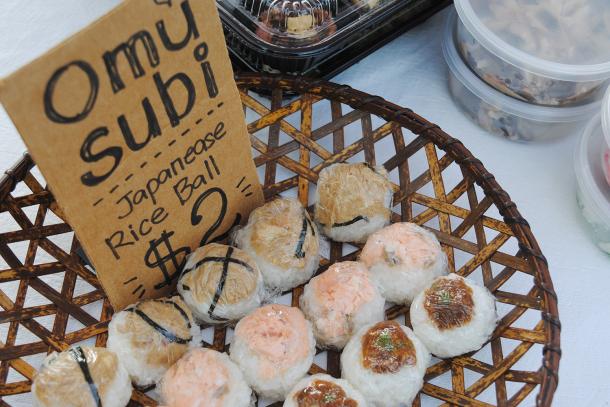Chasing Umami: Unlocking the Magic of Japanese Koji Fermentation
Kayla Abe, CUESA Staff
January 25, 2017
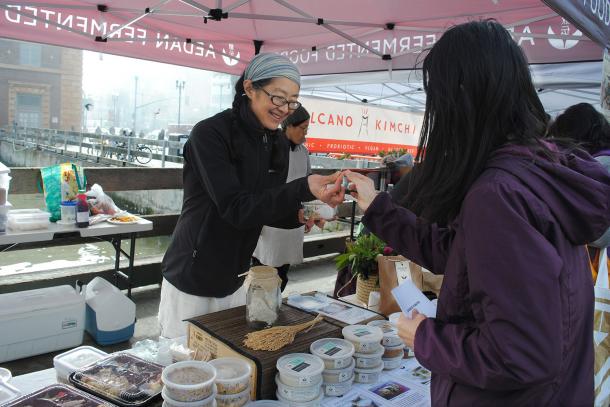
Umami, the elusive fifth taste, is an enigma to many Western palates: how is it savory but not necessarily salty, or meaty without the presence of meat? Through Aedan Fermented Foods’ umami-rich sauces and marinades, fermentation guru Mariko Grady is deepening the Bay Area’s appreciation of Japanese flavors, one palate at a time.
“The easy way to achieve umami is MSG,” Mariko explains as she offers a sample to a shopper at the Ferry Plaza Farmers Market. “But this miso is all-natural umami.”
The grilled tofu, boiled daikon turnip, and pickled watermelon radish samples at Aedan’s stand show the breadth of uses for Mariko’s products—a dollop of sweet miso sauce on some, a shio koji marinade on others. Every Saturday, these bites transform tentative shoppers into wide-eyed proponents of the flavor magic of koji fermentation.
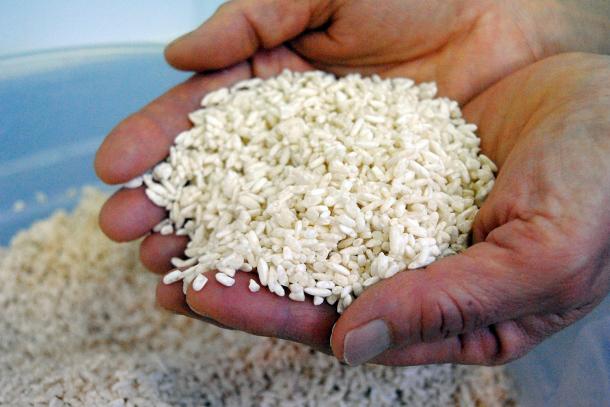
What Is Koji?
Japanese fermented foods like soy sauce, sake, and miso draw from the same ingredient family: rice, salt, soybeans, and koji—a natural, live fungus. With minor adjustments to cooking temperature and fermentation time, Mariko’s products reveal the wide array of bold flavors that koji can unleash (see tips below).
From soups to sauces, and dips to dressings, most meals in Japan rely on some koji-based ingredient. In the compact quarters of the Japanese household, limited refrigerator space necessitates that each condiment serve a wide range of applications, making multifunctional miso and koji staples in kitchens across Japan.
Easy to use and rich in probiotics, these fermented foods inspire a philosophy of holistic living, in Mariko’s view. Even the production process embodies a simpler, homegrown ethos that connects us back to nature. “This miso is made just with room-temperature microorganisms working for us,” she says.
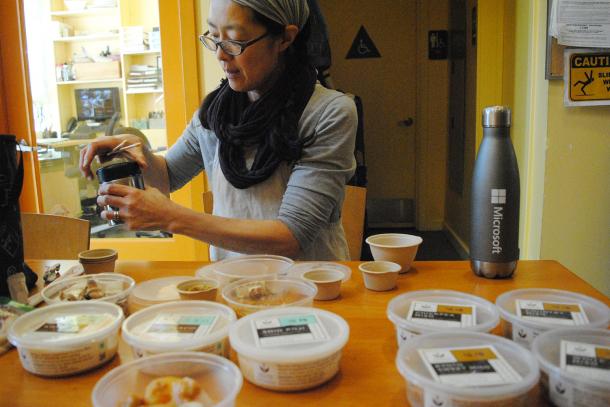
From Philanthropy to Ferments
Aedan Fermented Foods was a serendipitous byproduct of a philanthropic project. Following the Fukushima earthquake and tsunami in 2011, Mariko began selling her miso to raise money for relief efforts in Japan. Making miso was an easy decision for the former performance artist, who already produced it regularly for her family. “In my performing arts life, we traveled, sometimes on world-wide tours, and always, I bring koji from Japan and make miso for my family,” says Mariko.
As her miso made its way through the Bay Area Japanese community, the demand quickly grew. To continue selling it, Mariko realized she needed insurance. “I knew it’s not legal to sell homemade goods on a large scale,” she recounts. “But to get insurance, I needed to use a commercial kitchen.”
She applied and was accepted into the food business incubator program at La Cocina, which offers regular access to kitchen space and technical assistance. Soon she began selling at Bi-Rite Market, Rainbow Grocery, and the Ferry Plaza Farmers Market. “I just wanted to donate money after Fukushima,” Mariko recounts. “I didn’t imagine I would start a business! Everything was little by little.”
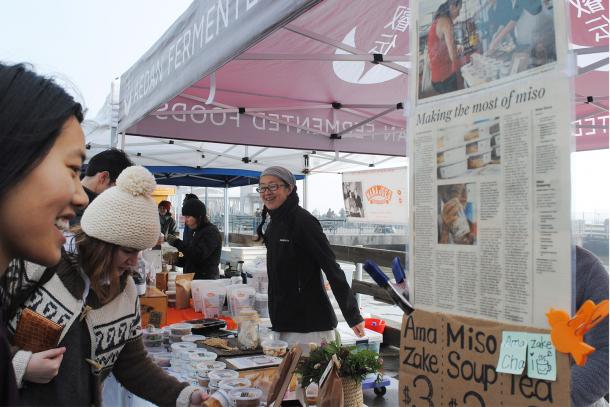
Growing the Miso Movement
Miso resonates with San Francisco food lovers for its unique flavor profile and versatility, but Mariko has even bigger hopes for her products. “I want to build a community with these foods,” she says. “I believe that even a small community is very important, especially for the future, if something happens. We need to help each other and share.”
Following the Fukushima earthquake, Mariko brings a lens of emergency preparedness to her life and work. “It’s good emergency food: miso mixed with water provides good nutrition, protein, and enzymes,” she explains. In the fridge, it can keep for years, and room-temperature miso is safe to eat for months. “My aim,” states Mariko, “is one family, one container of miso at home.”
As Mariko spreads the word about miso and koji at the farmers market, in her workshops, and at youth cooking classes, she shares her message of holistic health, simple living, and connection. “I really enjoy sharing with customers on Saturday at the market,” says Mariko. “It’s my pleasure and passion to share this very good, healthy food with the Bay Area.”
Find Aedan Fermented Foods on Saturdays at the Ferry Plaza Farmers Market in the south driveway.
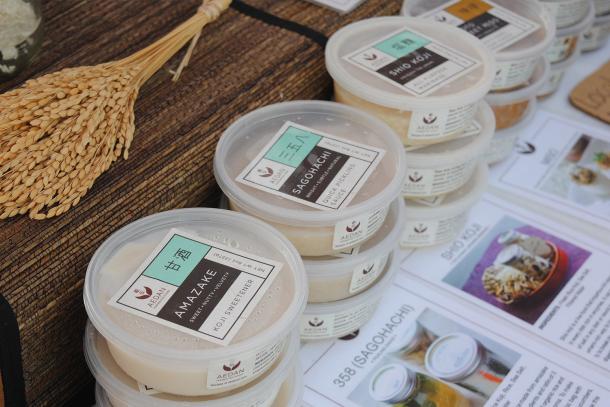
Building a Japanese Pantry
Want to add more umami to your life? Here’s a quick introduction to the products you can find at Aedan’s Saturday market stand, with some simple tips for enjoying them.
Amazake: Natural Sweetener and Traditional Japanese Drink
Sweet with no added sugar, and naturally creamy without any dairy, amazake is a traditional Japanese drink made simply from mochi rice, koji, salt, and water. Once heated, koji releases enzymes that break down rice starches into sugars, creating a natural sweetness without the unhealthy repercussions of refined sugar. Add 2 to 3 parts hot water to drink amazake in the traditional Japanese way, or add fruit and freeze for a healthy “vegan ice cream.” Also great as a substitute sweetener while cooking.
Ingredients: Mochi Rice + Rice Koji + Salt + Water
Shio Koji: Umami Marinade
Your new favorite marinade! Add natural umami to vegetables and tofu, and tenderize meats as the koji enzymes break down proteins. Use 3 tablespoons shio koji per pound of vegetables or meats. Marinate for a few hours or up to a couple days for a stronger flavor and a tender, silken texture in protein-rich foods. Try marinating while vegetables are warm to activate the koji enzymes and bring out sweetness. Low in sodium, but strong in salty flavor, making for a great salt substitute. Popular among vegetarians and vegans.
Ingredients: Rice Koji + Salt + Water
Sagohachi: Quick Pickle Sauce
Pickle your favorite vegetables in as little as 30 minutes. Use 2 parts vegetables to 1 part sagohachi (in weight) for a sweet, umami-rich pickle. The excess water that collects after marinating vegetables is still full of healthy enzymes, so be sure to reuse it in a sauce or dressing to reap all the nutritious benefits.
Ingredients: Amazake + Salt
White Miso
This is the type of miso you are probably most familiar with: light, lower in sodium, bright in umami, with a touch of sweetness. Wonderful for soups, sauces, and dressings. Fermented for 6+ months.
Ingredients: Rice Koji + Soybeans + Salt + Water
Country Miso
A bolder, nuttier version of the white miso, thanks to the addition of barley koji. This miso was a finalist in the Good Food Awards, and is a Bay Area chef favorite. Fermented for 6+ months.
Ingredients: Barley Koji + Rice Koji + Soybeans +Salt + Water
Kyoto Sweet Miso
A slightly sweeter version of the white miso. A boost in koji leads to a shorter fermentation time of just 1 month and an abundance of healthful enzymes.
Ingredients: Rice Koji + Soybeans + Salt + Water
Chickpea Miso
A chickpea-based miso for those soy-free eaters out there to enjoy all the health benefits and flavors of miso too!
Ingredients: Chickpeas + Rice Koji + Salt + Water
Omusubi
Japanese rice balls with various seasonal toppings using Aedan’s misos and marinades. Available only at the farmers market.
Market Bento
A box lunch with a rotating assortment of fermented Japanese dishes made with Aedan’s products. It’s a great place to start if you’re looking to explore Aedan’s array of flavors. Available only at the farmers market.
Sweet Miso Sauce Recipe
2 tablespoons miso
2 tablespoons amazake
1 tablespoon ground sesame seeds
1 tablespoon sesame oil
Heat sesame oil in a pan, and mix in your favorite miso, amazake, and sesame seeds. Incorporate well. Serve with cooked winter root vegetables, like daikon, turnips, and carrots.
Topics: Building Equity program, Culinary, Food makers, Nutrition

